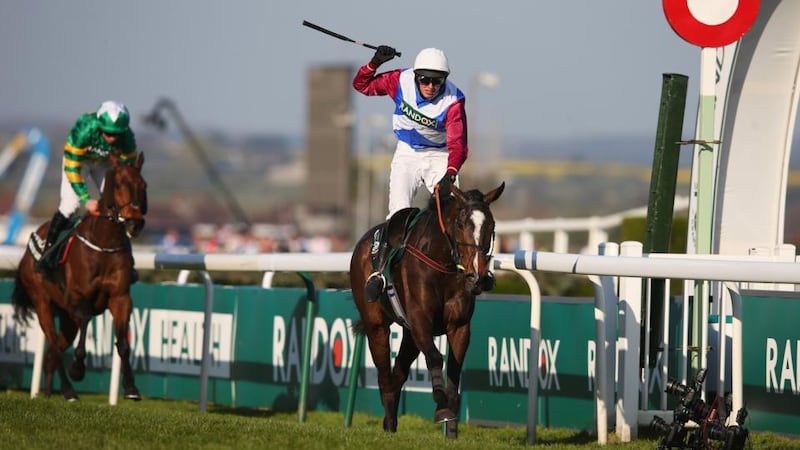The Aintree Grand National is racing’s best recruiting agent for the next generation. It’s how I got hooked to racing as a kid. Tales of Red Rum & Co seemed impossibly exciting. But my eleven-year-old won’t even consider watching it this Saturday.
It’s not just the National. It’s racing in general. And the reason is simple. He doesn’t like jockeys whipping horses to make them go faster. He says it’s ugly. How would you like it he argues. So I went through the various greys in response to his black and white view.
Like how having a philosophical debate with an animal about what to do and where to go isn’t really a runner; how the modern day whip is very different beast from the employed in my youth; and that living the life of a pampered equine athlete can seem pretty damn attractive sometimes.
But it always comes up against the aesthetics of how grisly it can look when jockeys whip horses. The horses have no choice is the reply in a tone which suggests looming ‘I-didn’t-ask-to-be-born’ adolescence.
What almost invariably comes too with the National’s shop window is an overall animal welfare debate that forces those of us in thrall to the game to test the ethics of thoroughbreds racing each other for the purposes of entertainment and gambling.
Because there are casualties. The thoroughbred is a maddeningly fragile creature. They can fatally injure themselves messing around in a paddock. So racing over jumps - in a sport sold on its ‘thrills n spills’ appeal - makes equine fatalities inevitable.
There’s a pact required with oneself to justify that, although it’s hardly Faustian. The thoroughbred has been created to race. Racing is its purpose.
It mightn’t feel particularly edifying sometimes. But considering how fraught so much of the rest of man’s relationship with the animal kingdom is some of the more anthropomorphic protests to racing from animal rights groups can seem childish.
However in perception terms the sport continues to do itself no favours in relation to the whip. There’s no getting away from how hitting an animal to make it go faster isn’t an attractive look. Especially when it’s unnecessary.
A whip is vital in terms of safety and correction: it’s optional in terms of making a horse go faster.
Generations of us are fine with that option. In fact depending on the size of investment plenty of us have been known to shout for more vigour rather than less when Ruby Walsh or Ryan Moore go into overdrive.
Generations change
But generations change and so do attitudes. Everyone was once fine with smoking in pubs. Now it’s unthinkable. And it’s hard not suspect time will make using a whip to gets horses to go faster seem distasteful to more and more people.
It’s no surprise most racing professionals instinctively reject that and respond with arguments that are logical in many ways.
If the public really is repulsed by jockeys using the whip how come Aintree will be thronged on Saturday. Hundreds of millions more will watch worldwide. So why should minority ignorance be pandered to: instead of banning the whip the public should be educated on its reality.
It’s true the modern racing whip is light years removed from those harsh connotations the word conjures. It’s much more about sound rather than pain. A slap across the hand is all the reassurance needed about it being more about encouragement than brutal coercion.
One leading jockey has argued with me that the problem is the word itself – “whip”. He maintains “cushioned stick” is more appropriate. Logically he might be right. Except aesthetics aren’t about logic. They’re primarily about emotion. One person hears cushion and another hears stick.
Except it’s disingenuous to represent the whip as little more than some glorified tickling stick with minimal input into making a horse go faster. For one thing if it’s largely irrelevant then why employ it at all. And crucially its relevance is regularly exposed to the sport’s detriment on its biggest stages.

Last Monday the jockeys on the first and second in the Irish Grand National, Irish racing’s richest and most prestigious jumps race, got suspended for seven and three days respectively over breaking the whip rules.
Last month Britain's champion jockey Richard Johnson won the Cheltenham Gold Cup on Native River and was banned for seven days for the same. The jockey on the runner up rode within the rules. Johnson kept the race.
Both instances are just the latest evidence of how jockeys break the rules if the potential reward is great enough. Yet they still get to win. There’s a contradiction there which cuts to the heart of sporting credibility.
All that has come from trying to square that circle is a fudge. It is illogical to break the rules and still win. So why not apply logic. Better still, try to find out if removing the whip for anything other than safety and correction proves a winner all-round.
Experiment for a period and see what happens. It might cause different problems. It might not. But it would remove a crucial visual one. So let’s find out. Because the thing is there’s no way to make hitting an animal look attractive.
Racing can’t exist in a vacuum and desperately needs to attract coming generations. Dismissing them as “snowflakes” with no appreciation of the reality of dealing with horses is fine. Arguing for more education on the whip is fine too. But hitting a horse still isn’t going to be pretty.
If time ultimately makes it unacceptable to use whips for making horses run then it’s in the sport’s ultimate self interest to take the initiative first.
The Grand National challenge has changed utterly in recent times because it had to. But it remains racing’s greatest draw. More proof perhaps that different and wrong don’t mean the same thing.













